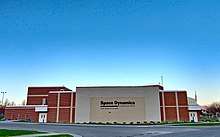Space Dynamics Laboratory
Space Dynamics Laboratory (SDL) is a nonprofit government contractor owned by Utah State University. SDL was formed in 1982 from the merger of Utah State University's Electro Dynamics Laboratories (founded in 1959) and the University of Utah's Upper Air Research Laboratory (founded in 1948).[3] The corporation has been responsible for the design, fabrication, and operation of sensors on over 430 payloads ranging from aircraft and rocket-borne experiments to space shuttle experiments and satellite-based sensor systems. SDL is the Missile Defense Agency's University Affiliated Research Center (UARC) and one of 14 UARCs in the nation. SDL provides sensor systems and supporting technologies to address challenges for the United States government. SDL designs and develops electro-optical sensors, builds small satellites, provides calibration services, and creates real-time data reconnaissance systems.[2]
 | |
 Looking west at the Space Dynamics Laboratory auditorium building in the morning | |
| Predecessor | Electro-Dynamics Laboratories (EDL), and Upper Air Research Laboratory (UARL) |
|---|---|
| Founded | 1959 |
| Headquarters | , |
Number of locations | 8[1] (2020) |
| Revenue | About $175 million[2] (FY2019) |
Number of employees | 900+[2] (FY2019) |
| Parent | Utah State University |
| Website | sdl |
SDL employs over 900 engineers, students, and professional staff at facilities in Logan, Utah; Albuquerque, New Mexico; Bedford, Massachusetts; Dayton, Ohio; Huntsville, Alabama; Houston, Texas; Los Angeles, California; and Washington, D.C.
History
SDL origins date back to 1948 with experiments by the University of Utah Upper Air Research Laboratory (UARL) to measure electron density in the upper atmosphere of Earth utilizing German V-2 rockets.[3] In 1959 the Electro-Dynamics Laboratories (EDL) was founded at Utah State University. The UARL relocated to Utah State University in 1970 and merged with EDL in 1982 to form SDL. One of the early missions involved measurements during Operation Dominic in 1962. In 1965 the laboratory participated in its 100th launch aboard a sounding rocket. In 1982 SDL participated in its first experiment (the Vehicle Charging and Potential experiment) aboard a space shuttle as part of STS-3.
Projects for NASA
SDL has been a contractor for NASA on a variety of missions for decades.[4] In 2019 NASA selected USU to conduct the Atmospheric Waves Experiment (AWE) led by Mike Taylor. AWE involves an imager built at SDL that will be mounted on the International Space Station to map airglow.[5] Other NASA projects include:
- Thermal links for infrared instruments on the James Webb Space Telescope.[4]
- SDL built and tested The Wide-field Infrared Survey Explorer science instrument used to discover thousands of minor planets and asteroids.[6]
- SDL designed, manufactured, and tested the cryogenic subsystems for the focal plane assemblies of OCO and of OCO-2.[7]
- Solar occultation for ice experiment (SOFIE) onboard the AIM satellite was designed and fabricated at SDL.[8]
- The Floating Potential Measurement Unit (FPMU) designed and built by SDL monitors surface charging of the ISS.[9]
- The detector electronics assemblies for the OSIRIS-REx Camera Suite (OCAMS) to image the asteroid, search for outgassing plumes, and document the sample acquisition.[10]
- Cryogenic Infrared Radiance Instrumentation for Shuttle (CIRRIS 1A) flew onboard Space Shuttle Discovery in 1991 as part of STS-39. CIRRIS was used to measure phenomena such as airglow and auroral phenomenology. SDL designed, built, and tested the instrument.[11]
- A major flight test unit subsystem for the Plankton, Aerosol, Cloud, ocean Ecosystem satellite was built at SDL.[12]
References
- "SDL - Locations". Space Dynamics Laboratory, Utah State University. Retrieved May 23, 2020.
- "SDL - Overview" (PDF). Space Dynamics Laboratory, Utah State University. Retrieved May 23, 2020.
- "SDL - History". Space Dynamics Laboratory, Utah State University. Retrieved May 23, 2020.
- "Space Dynamics Laboratory Delivers James Webb Space Telescope Subsystem to NASA". spaceref.com. Utah State University. February 3, 2014. Retrieved May 13, 2019.
- "USU's Atmospheric Waves Experiment chosen by NASA for mission to study space weather". sdl.usu.edu. KUTV. March 6, 2019. Retrieved May 13, 2019.
- "Wide-field Infrared Survey Explorer". sdl.usu.edu. Space Dynamics Laboratory. Retrieved May 13, 2019.
- "Orbiting Carbon Observatory". sdl.usu.edu. Space Dynamics Laboratory. Retrieved May 13, 2019.
- "Aeronomy of Ice in the Mesosphere Solar Occultation for Ice Experiment". sdl.usu.edu. Space Dynamics Laboratory. Retrieved May 13, 2019.
- "Floating Potential Measurement Unit" (PDF). sdl.usu.edu. Space Dynamics Laboratory. Retrieved May 13, 2019.
- "OSIRIS-REx" (PDF). sdl.usu.edu. Space Dynamics Laboratory. Retrieved May 13, 2019.
- "Cryogenic Infrared Radiance Instrumentation for Shuttle". sdl.usu.edu. Space Dynamics Laboratory. Retrieved July 26, 2019.
- Cortez, Marjorie (Apr 21, 2020). "USU Space Dynamics Lab delivers test unit to NASA for spacecraft set for 2022 launch". Retrieved May 23, 2020.